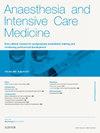抗焦虑药,镇静剂和催眠药
IF 0.3
Q4 ANESTHESIOLOGY
引用次数: 0
摘要
抗焦虑药、镇静剂和催眠药在现代临床实践中发挥关键作用,促进程序、管理焦虑,并确保在各种医疗保健环境中充分镇静。本文提供了其作用机制的全面概述,重点介绍了这些药物如何调节中枢神经系统活动以达到治疗效果。苯二氮卓类药物和α-2肾上腺素能激动剂作为基础药物进行了讨论,详细介绍了它们的药效学和药代动力学特征。本文进一步探讨了静脉(IV)和吸入麻醉剂的特性,比较了它们的疗效、起效、作用持续时间和安全性。特别强调的是决定药物选择的临床情况,以及考虑患者特定因素,如合并症和程序要求。通过将药理学见解与实际应用相结合,本综述旨在指导临床医生优化使用抗焦虑药、镇静剂和催眠药,确保患者安全和手术成功。本文章由计算机程序翻译,如有差异,请以英文原文为准。
Anxiolytics, sedatives and hypnotics
Anxiolytics, sedatives, and hypnotics play a pivotal role in modern clinical practice, facilitating procedures, managing anxiety, and ensuring adequate sedation in various healthcare settings. This article provides a comprehensive overview of their mechanisms of action, highlighting how these agents modulate central nervous system activity to achieve therapeutic effects. Benzodiazepines and α-2 adrenergic agonists are discussed as cornerstone agents, detailing their pharmacodynamic and pharmacokinetic profiles. The article further explores the properties of intravenous (IV) and inhalational anaesthetic agents, comparing their efficacy, onset, duration of action, and safety profiles. Special emphasis is placed on the clinical scenarios dictating the choice of agents, as well as considerations for patient-specific factors such as co-morbidities and procedural requirements. By integrating pharmacological insights with practical applications, this review aims to guide clinicians in the optimal use of anxiolytics, sedatives, and hypnotics, ensuring patient safety and procedural success.
求助全文
通过发布文献求助,成功后即可免费获取论文全文。
去求助
来源期刊

Anaesthesia and Intensive Care Medicine
ANESTHESIOLOGY-
CiteScore
0.50
自引率
0.00%
发文量
152
期刊介绍:
Anaesthesia and Intensive Care Medicine, an invaluable source of up-to-date information, with the curriculum of both the Primary and Final FRCA examinations covered over a three-year cycle. Published monthly this ever-updating text book will be an invaluable source for both trainee and experienced anaesthetists. The enthusiastic editorial board, under the guidance of two eminent and experienced series editors, ensures Anaesthesia and Intensive Care Medicine covers all the key topics in a comprehensive and authoritative manner. Articles now include learning objectives and eash issue features MCQs, facilitating self-directed learning and enabling readers at all levels to test their knowledge. Each issue is divided between basic scientific and clinical sections. The basic science articles include anatomy, physiology, pharmacology, physics and clinical measurement, while the clinical sections cover anaesthetic agents and techniques, assessment and perioperative management. Further sections cover audit, trials, statistics, ethical and legal medicine, and the management of acute and chronic pain.
 求助内容:
求助内容: 应助结果提醒方式:
应助结果提醒方式:


